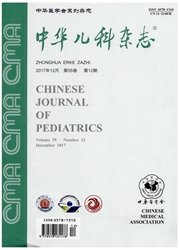

 中文摘要:
中文摘要:
目的探讨KCNB1基因的表型和基因型的关系。方法回顾性分析1例2014年6月在中南大学湘雅医院儿科接诊,2016年1月明确诊断的KCNB1基因突变导致智力障碍合并难治性癫痫患儿的临床资料,并以“KCNB1”为检索词通过Pubmed、CNKI、人类基因组突变数据库(HGMD)和在线人类孟德尔遗传数据库(OMIM)等数据库对国内外文献进行检索,总结KCNBI基因突变患儿的临床表型及其与基因型的关系。结果患儿男,3岁6月龄,2岁时因“发育迟缓”首次门诊就诊,诊断考虑“精神运动发育迟滞”,既往13月龄首先出现抽搐发作,脑电图未见明显异常,未重视。随诊期间于2岁10月龄再次出现抽搐,3岁抽搐情况加重,发作形式多样,可表现为强直、阵挛及痉挛发作,脑电图示清醒期及NREM期放电指数高(〉85%),通过多种抗癫痫药物、激素、生酮饮食等均无法控制抽搐发作,3岁起出现精神运动发育倒退,体格检查示肌张力低,独坐不稳,不能独站,无语言交流。通过全外显子测序技术检测出该患儿KCNB1新生杂合错义突变,突变位点为e.G1136T(p.G379V),且上述数据库均未记载。国内尚无KCNB1基因突变患儿记录,国外文献共报道8例,突变均为新发错义突变,表型为癫痫脑病。结论KCNB1基因突变患者的主要临床表型为重度智力障碍合并难治性癫痫,查体可见肌张力减低,后期可伴有精神运动发育倒退,预后差。
 英文摘要:
英文摘要:
Objective To explore the association between the phenotype and KCNB1 gene mutation. Method Clinical information including physical features, laboratory and genetic data of one patient of mental retardation with refractory epilepsy from Department of Pediatrics, Xiangya Hospital in January 2016 was analyzed. This patient was discovered to have KCNB1 gene mutations through whole exome sequencing. Relevant information about KCNB1 gene mutation was searched and collected from Pubmed, CNKI, Human Gene Mutation Database (HGMD) and Online Mendelian Inheritance in Man (OMIM). Searching was done using "KCNB1" as a keyword. Result A 3.5 years old boy who visited our hospital firstly at the age of 2 years because of development delay came for follow up as he developed seizures. The forms included tonic, clonic seizures and spasm. The condition became more severe 10 months later. Electroencephalogram(EEG) showed high frequency discharge ( 〉 85% ). He had poor response to multiple anti-epileptic drugs, methylprednisolone and ketogenic diet. At the age of 3, he started to have mental regression. Whole exome-sequencing study (trios) identified a novel heterozygous mutation c. Gl136T (p. G379V) in KCNB1, which is not available in the databases mentioned above. This is the first case report of KCNB1 gene mutation in China. Eight cases have been reported so far worldwide and all of them were diagnosed with refractory epilepsy. Those 8 reported cases of encephalopathy were all due to de novo mutation. Conclusion The main clinical features of patients with KCNB1 mutations include severe to profound intellectual disability, intractable seizures, hypotonia and regression of cognition and motor activity which lead to poor prognosis.
 同期刊论文项目
同期刊论文项目
 同项目期刊论文
同项目期刊论文
 期刊信息
期刊信息
